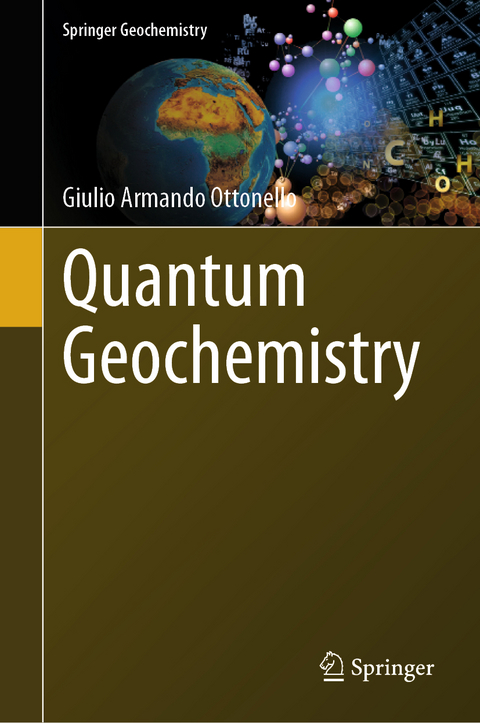
Quantum geochemistry
Springer International Publishing (Verlag)
978-3-031-21836-1 (ISBN)
lt;p>Principles
1) Some recalls on Physical basis:
1-1)
roman";"=""> Statistical interpretation of a wave function1-2) Effect of an external potential on the time-dependent and time-independent Schrödinger equation
1-3)
The Quantum Mechanical Hamiltonian1-4) The postulates of Quantum Mechanics (Operators and eigenvalue equations; Eigenvalue equations in vector space; The expectation value postulate; The uncertainty principle; Eigenfunction sets)
1-5)Probability density and Probability Current
/p>1-6)The Schrödinger equation in momentum space and generalized coordinates1-7) The Harmonic oscillator - general representation
px; margin-top: 0cm; margin-bottom: 0cm; margin-left: 70.9pt; text-indent: -52.9pt;">1-8)Thermal energy and nuclear motionMethods
2) Gaussian Basis Sets (Exponents optimization; Polarized and diffuse functions)
3) Plane waves (LDA; GGA; PWSCF; LAPW )4)Pseudo-potentials
5)
size: 14px;">Functionals5-1) Harthree-Fock (HF and electron correlation; Restricted HF, Restricted Open HF)5-2) Density Functionals (The Colle-Salvetti Theorem and the Lee-Yan-Parr approximation)
10pt; text-indent: -52.9pt;">5-3) Hybrid functional (Local Density Approximation; General Gradient Approximation) Generalities about Observables6) Thermodynamic parameters (to be expanded)
alibri , sans-ser^ 7) Thermophysical parameters (to be expanded) 8) Spectroscopic parameters (to be expanded)Applications
9) Gaseous species: The isolated gaseous molecule: elect
ron energy and zero-point energy; Electron-convention and Ion-Convention; Adiabatic vs Vertical IMolar Entropy and Molar Gibbs free energy of formation from the elements; Molar Volume; Dissociation energy of some geologically relevant gaseous species10) &nbSolvation energy; Scaling from "absolute" to "conventional" magnitudes; Thermochemical cycles and the "Hydronium Ion" [H3O]+; Entropy of aqueous species; Basicity of acids: The Acetic Acid as an example; The pKa scale of organic and inorganic acids; The individual ionic activity coefficient in acqueous solutions of different ionic strenght; Thermodynamic properties of aqueous species with heavy atoms;11) Silicate Melts: Silicate melts as dielectric media; Tetrahedral symmetry: the role of sp3 hybridization; The effect of ad-ions on the orbital energy on oxygen centers: inner and external orbitals; Polymeric structures and the role of electron localization - electron delocalization in determining bond strength and medium range symmetry; Silicate melts as solvents: applications of The Scaled Particle Theoryt" style="font-size:12) Crystals12-1) Lattice geometry (Translational symmetry; Unit Cell; Point Groups; Space Groups; Symmetry restrictions imposed by periodicity; Basis sets effect; HF for open shell crystals UHF for periodic systems)
ly: Calibri , sans-serif;">12-2) Periodic boundary conditions and Bloch functions (Density of states; Bond structure; Fermi Energy and Fermi Surface)12-3) Density of States, Bond Structure Fermi Energy and Fermi Surface12-4) Lattice Dynamics and Thermal Properties (Model Potential Functions; Harmonic Approximation; Born Matrix and Dispersion Relation; Experimental Methods and empirical fittings; Quantum Mechanical derivation of Force Constants)
an>12-5) Thermal stress and electron delocalization (Bader Analysis; Topological weaknesses; Thermally-induced bond-weakening; Buckenau assumption and RUM modes)12-6) Observables (Total Energy and related Properties; The formation energy and other energy differences; The equilibrium geometry; EOS and Phase transitions; Bulk mod
ulus and elastic constants; Thermodynamic properties: energy quantization and phonons; Thermodynamic functions and Density of States; Quasi harmonic Model; Thermal expansion;; The asymmetric potential well: evidences from discrete static potential calculations; The Coulomb, repulsive and dispersive potentials;; Madelung Energy; Thermal energy and thermal expansion: the shift of the potential energy minimum; Surface Energy; Surfaces and Local Defect; One electron density matrix and related observables )&nb
sp;13) Isotopomeric energy and isotopic fractionation 13-1) Nuclear mass and vibrational properties (Separative effect and equilibrium exchanges; Bigeleisen-Mayer approximation; Kieffer rules; The "Isotopic Hergodicity Principle"; Reaction Kinetics and isotope exchange; Diffusion induced Isotope fractionation.13-2) Nuclear Mass and Relativistic effects
001pt;tab-stops:0cm"> Calibri, sans-serif;">13-3) Ab-initio Stable Isotopes (C-H-O-S)13-4) Ab-initio transition metals (Fe-Cu-Cr)13-5) Ab-initio Metallomics (Ca); margin-top: 0cm; margin-bottom: 0cm; margin-left: 21.3pt;">APPENDIX1) Operators and eigenvalue equations (Self-adjoint form and Hermite equations; Properties of eigenfunctions; Eigenfunction expansions; Orthogonality of eigenfunctions; Adjoint operators and Hermitian symmetry)2) Separation of differential equations3) The metric tensor 4) Reciprocal Lattice 5) The Block Theorem6); line-height: normal;" times="" new="" ro Plane waves7) Gaussian Functions
ize: 14px;">
| Erscheinungsdatum | 10.05.2024 |
|---|---|
| Reihe/Serie | Springer Geochemistry |
| Zusatzinfo | Illustrationen |
| Verlagsort | Cham |
| Sprache | englisch |
| Maße | 155 x 235 mm |
| Themenwelt | Naturwissenschaften ► Geowissenschaften ► Geologie |
| Schlagworte | Gaussian basis sets • Harmonic oscillator • isotopic fractionation • Lattice geometry • Quantum Mechanical Hamiltonian • Schrödinger equation |
| ISBN-10 | 3-031-21836-1 / 3031218361 |
| ISBN-13 | 978-3-031-21836-1 / 9783031218361 |
| Zustand | Neuware |
| Informationen gemäß Produktsicherheitsverordnung (GPSR) | |
| Haben Sie eine Frage zum Produkt? |
aus dem Bereich


